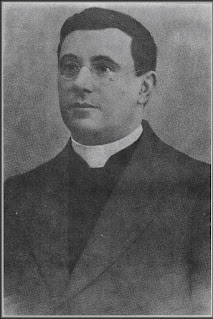Devout Catholic murdered for opposing Fascists
 |
| Giovanni Minzoni objected to the Fascist youth movement in his town |
A parish priest in the town, midway between the cities of Ferrara and Ravenna, Don Minzoni was attacked at around 10.30pm as he returned to his rectory in the company of Enrico Bondanelli, a parishioner, when he was set upon by two men who were attached to a Fascist militia in Casumaro, almost 50km (31 miles) from Argenta on the other side of Ferrara.
He was pelted with stones and, when the blows made him fall to the ground, was beaten. What proved to be the fatal blow was struck with a heavy walking stick. He had a fractured skull and, despite being helped home by Bondanelli and neighbours, died a couple of hours later. His attackers were later named as Giorgio Molinari and Vittore Casoni, who were allegedly acting on the orders of Italo Balbo, a Blackshirt Commander who would later be seen as an heir to dictator Benito Mussolini.
Don Minzoni, a former military chaplain, had made no secret of his opposition to the Fascist regime. Shortly before he was attacked, he had set up a Catholic Scout group in Argenta in response to the introduction in the town of the Opera Nazionale Balilla, the Fascist youth movement.
He had been involved in a stand-off with the local militia when he invited Father Emilio Faggioli, a leading figure in the Catholic Scout organisation in Emilia-Romagna, to give a talk about the virtues of Catholicism and the scouts in the parish hall on Piazza d’Argenta, the town’s main square.
.jpg) |
| Blackshirt Italo Balbo (second right) was suspected of ordering the murder |
A militia chief attempted to bring Don Minzoni over to his side by offering to make him the chaplain of their group. Not surprisingly, the priest refused. He did not expect his decision to be well received and an entry in his diary chillingly anticipated his fate:
“With an open heart, with a prayer for my persecutors that will never disappear from my lips, I await the tempest, the persecution, maybe even death, for the cause of Christ to triumph.”
Born into a middle class family in Ravenna, Minzoni chose at an early age to dedicate his life to Christianity and was ordained a priest at the age of 24. He was made deputy pastor in Argenta, a position he held for three years before leaving to study in Bergamo, in Piedmont, where he graduate in 1914.
He was to have returned to Argenta in 1916 to become parish priest of San Nicoló, following the death of the incumbent, but instead was called by the army of the Kingdom of Italy, who asked him to serve as a military chaplain on the Italian north-eastern front. He was awarded the Silver Medal of Military Valour after showing great courage in the field during the Battle of the Piave River.
.jpg) |
| Don Minzoni is commemorated in the names of streets and squares in many Italian towns and cities |
His murder was covered extensively by two still relatively free newspapers, Il Popolo and La Voce Repubblicana, who named the perpetrators. When they came to trial, however, Molinari and Casoni along with Balbo were acquitted, the process effectively collapsing because intimidation of journalists and witnesses made a fair hearing impossible.
A re-trial did take place at the end of World War Two, in which Molinari and Casoni were found guilty of second degree murder. Balbo, who had been killed when the plane in which he was a passenger was shot down over Libya in 1940, was absolved of blame.
After the war, Don Minzoni became a symbol of the Italian Catholic Resistance, and many books were written about him. Pope John Paul II recalled his courage in a letter to the Bishop of Ravenna in 1983, on the 60th anniversary of his death, when his remains were moved from the monumental cemetery of Ravenna to the Cathedral of San Nicolò in Argenta.
 |
| The Cathedral of San Nicolò di Argenta, with the monument to Don Manzoni in the foreground |
Argenta, which is situated about 30 kilometres (19 miles) southeast of Ferrara and a little over 40km (25 miles) northwest of Ravenna, is a town of Roman origin in a flat agricultural region near the Valli di Comacchio lagoon wetlands, much of which is designated as a wildlife sanctuary with many facilities for ornithology. Situated close to the German Gothic Line, it suffered damage in World War Two. In 1973, a monument to Don Giovanni Minzoni, sculpted in bronze by Angelo Biancini, was placed in front of the Cathedral of San Nicolò di Argenta, when celebrations of his life in the town were inaugurated by the President of the Republic, Giovanni Leone.
.JPG) |
| The Basilica of San Vitale in Ravenna is famous for its beautiful Byzantine mosaics |
Ravenna, where Giovanni Minzoni was born, became the capital city of the western Roman empire in the fifth century. It is known for its well preserved late Roman and Byzantine architecture and has eight UNESCO world heritage sites. The Basilica of San Vitale is one of the most important examples of early Christian Byzantine art and architecture in Europe, famous for its superb Byzantine mosaics. The poet Dante died while living in exile in Ravenna in about 1321. He was buried at the Church of San Pier Maggiore in Ravenna and a tomb was erected there for him in 1483. Another tomb was built for Dante in the Basilica di Santa Croce in Florence but despite repeated requests for the return of Dante’s remains to the city of his birth, Ravenna has always refused.
Also on this day:
1945: The birth of teenage pop star Rita Pavone
1943: The birth of guitarist and composer Pino Presti
1974: The death of eminent psychiatrist Roberto Assagioli
.jpg)




.jpg)
.jpg)
.jpg)
%20(2).jpg)



.jpg)